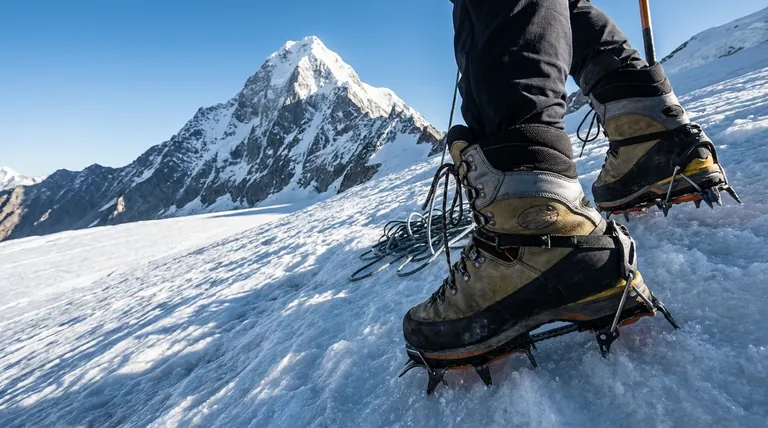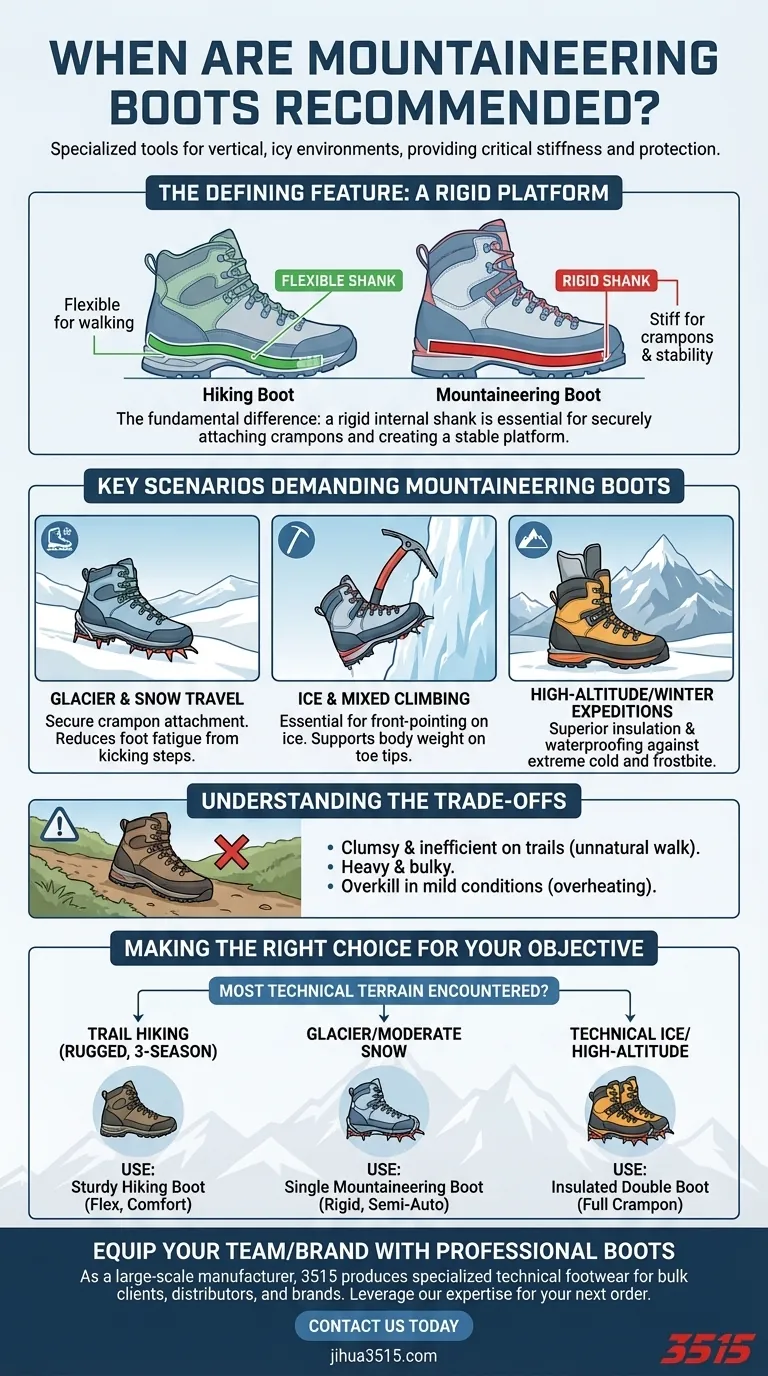Mountaineering boots are recommended when your objective involves travel on glaciers, snowfields, or technical ice where the use of crampons is required. They are specialized tools designed for vertical environments, providing the critical stiffness and weather protection that standard hiking boots lack.
The decision to use mountaineering boots over hiking boots comes down to a single, non-negotiable feature: a rigid sole. This stiffness is essential for securely attaching crampons and providing a stable platform for safe travel on snow and ice.

The Defining Feature: A Rigid Platform
The fundamental difference between a hiking boot and a mountaineering boot lies in its internal structure, specifically the shank.
What is a Shank?
A shank is the supportive component between the insole and the outsole that provides the boot's rigidity. In hiking boots, this shank is flexible to allow a natural walking motion.
Why Stiffness is Critical
In a mountaineering boot, the shank is extremely stiff, often completely rigid. This creates a solid platform that will not bend under load.
This rigidity is crucial for preventing crampons from flexing and popping off your foot, which could be catastrophic on steep terrain. It also allows you to kick steps into hard snow and stand securely on tiny rock edges.
Key Scenarios Demanding Mountaineering Boots
Using a mountaineering boot is not about the difficulty of a trail, but the nature of the terrain itself. They are purpose-built for specific conditions.
General Mountaineering and Glacier Travel
Crossing a glacier or a permanent snowfield requires crampons for traction and safety. The stiff sole of a mountaineering boot provides the necessary platform for attaching them securely.
The rigidity also reduces foot fatigue when kicking steps into the snow for hours on end, a common technique for ascending snow slopes.
Ice and Mixed Climbing
For ascending frozen waterfalls or terrain that mixes rock and ice, mountaineering boots are absolutely mandatory.
The boot's stiffness allows a climber to front-point—kicking the front spikes of their crampons into vertical ice—and support their entire body weight on the tips of their toes. A flexible hiking boot would simply fold, making this impossible.
High-Altitude or Winter Expeditions
These environments demand superior protection from the cold and wet. Mountaineering boots offer significantly more insulation and more robust waterproofing than any hiking boot.
They are often available in "double boot" configurations, with a removable insulated liner, to protect against frostbite in extreme temperatures.
Understanding the Trade-offs
Choosing a mountaineering boot for the wrong activity creates significant problems and can even increase risk. Their specialized design comes with clear disadvantages on normal terrain.
The Problem with Stiffness on Trails
The very rigidity that makes a mountaineering boot excel on ice makes it clumsy and inefficient for regular hiking.
The lack of flex forces an unnatural, flat-footed, or "Frankenstein" walking motion on trails. This quickly leads to exhaustion, hot spots, and blisters.
Weight and Bulk
Mountaineering boots are substantially heavier and bulkier than hiking boots. This added weight on your feet drains energy far more quickly over long distances.
Overkill in Milder Conditions
The heavy insulation and robust waterproofing that protect you in the alpine can cause your feet to overheat and sweat excessively in three-season conditions, leading to discomfort and blisters.
Making the Right Choice for Your Objective
Select your footwear based on the most technical terrain you will encounter, not the majority of the approach.
- If your primary focus is trail hiking, even on rugged, three-season terrain: A sturdy hiking boot is the correct tool, providing the necessary flex, comfort, and support for walking.
- If your primary focus involves crossing glaciers or ascending moderate snow slopes: A single-layer mountaineering boot compatible with semi-automatic crampons is your essential starting point.
- If your primary focus is technical ice climbing or a high-altitude expedition: A heavily insulated double boot with full crampon compatibility is non-negotiable for safety and performance.
Ultimately, choosing the right boot is the foundation of your safety and success in the mountains.
Summary Table:
| Scenario | Why Mountaineering Boots Are Needed |
|---|---|
| Glacier Travel & Snowfields | Provides a rigid platform for secure crampon attachment and reduces foot fatigue from kicking steps. |
| Ice & Mixed Climbing | Essential stiffness supports front-pointing on vertical ice; a flexible boot would fold. |
| High-Altitude/Winter Expeditions | Offers superior insulation and waterproofing to protect against extreme cold and frostbite. |
Ready to equip your team or brand with professional-grade mountaineering boots?
As a large-scale manufacturer, 3515 produces a comprehensive range of specialized footwear for distributors, brand owners, and bulk clients. Our production capabilities encompass all types of technical boots, including the rigid, insulated models essential for mountaineering safety and performance.
Contact us today to discuss your specific needs and leverage our manufacturing expertise for your next order.
Visual Guide

Related Products
- Factory-Direct Wholesale Canvas Boots with High-Traction Rubber Soles
- Safety Footwear Wholesale Manufacturer for Custom OEM/ODM Production
- Wholesale High-Traction Camo Boots - Custom Manufacturer for Brands
- Durable High-Ankle Tactical Boots Wholesale Manufacturer for Custom & Bulk Orders
- Wholesale Safety Footwear Manufacturer for Bulk & Custom OEM Orders
People Also Ask
- Why is rubber a popular material for shoe soles? Unbeatable Grip, Durability & Value
- What is a vulcanized sole? Discover the Secret to Superior Flexibility and Grip
- What factors determine the slip resistance of rubber-soled shoes? Tread, Compound & Design Explained
- What types of rubber are typically employed in non-slip footwear soles? Your Guide to Maximum Grip and Safety
- What should be avoided when storing boots with outsoles? Protect Your Investment from Dry Rot & Decay



















